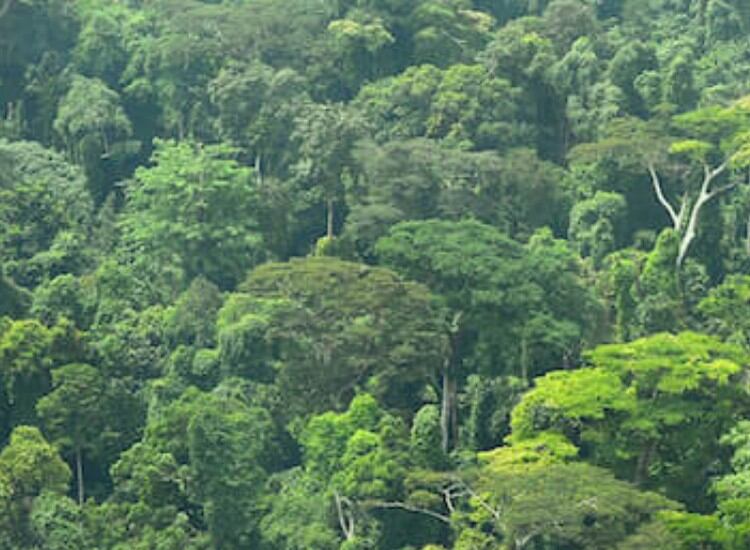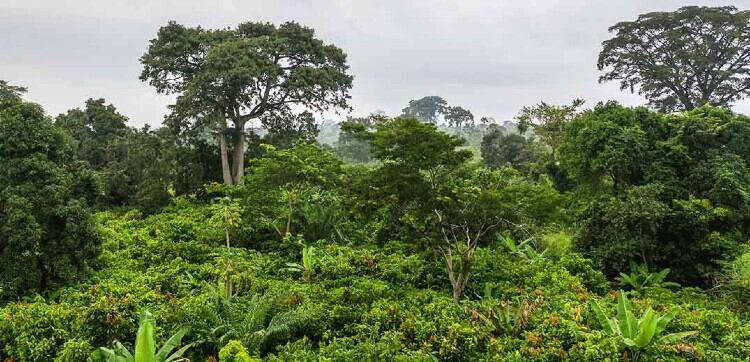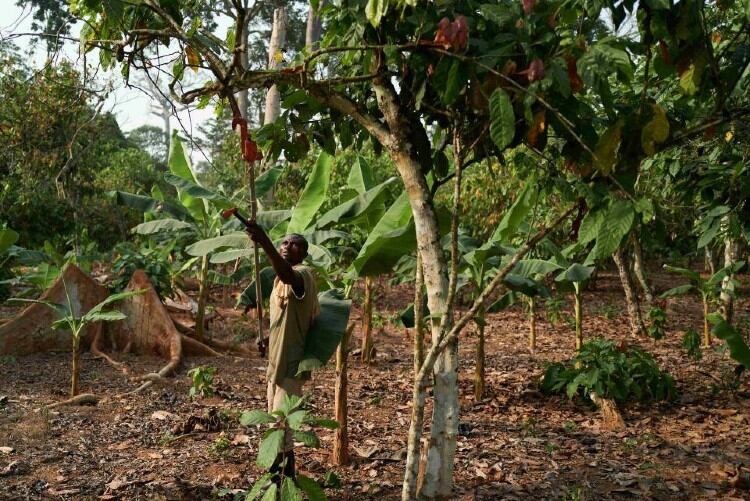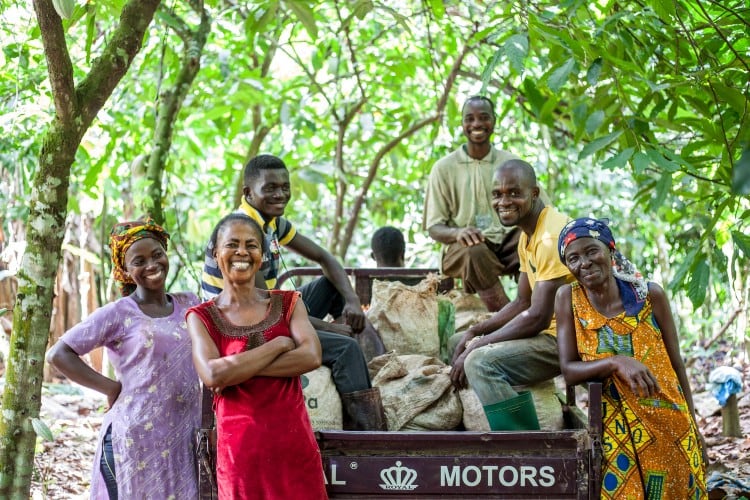The latest study by Cote d’Ivoire’s Conseil du Café-Cacao (CCC), the country’s cocoa regulator, has revealed approximately 15% of its cocoa farms are in protected forest areas, which will put it at odds with any upcoming European Union law.
Alain-Richard Donwahi, the Ivorian minister of water and forests, has called for a unified national cocoa traceability system and the national forest monitoring and deforestation early warning system to help end deforestation in cocoa-growing regions.
Writing in the Cocoa & Forests Initiative (CFI) 2020 progress report, he said: “In addition to the major challenge of mobilising the financial resources required for the successful implementation of CFI, there is another linked to establishing the unified national cocoa traceability system and the national forest monitoring and deforestation early warning system alongside a monitoring and verification mechanism.
“This is an important challenge to be addressed, given the increasing pressure from cocoa consumers and civil society organisations to ensure traceability of exported agricultural and forestry commodities.”
CFI Progress Snapshot
- Cote d’Ivoire adopted a national satellite system to monitor deforestation for CFI, and planted almost 10 million trees in 2020, aiming to extend forest cover to 20% of the country
- Ghana restored about 226,000 hectares of forest area, or 870 football fields per day, in 2020 with cocoa landscape partnerships
- Cocoa and chocolate companies have distributed 10.4 million forest trees since 2018 and reached 82% (Ghana) and 74% (Côte d’Ivoire) traceability in direct sourcing in 2020
In two joint public-private sector reports released this month, the CFI said all signatories are improving the traceability of the cocoa supply chain and notably, the government of Cote d’Ivoire has mapped all cocoa farms through a national operation conducted by the (CCC).
Donwahi’s comments come as the EU, one of the main importers of cocoa beans, is set to introduce legislation aimed at banning products sold in its jurisdiction that can be traced to deforestation, child labour and farmer poverty.
Deforestation is a major issue in Cote d’Ivoire and Ghana, which together produce nearly two-thirds of the world’s supply of cocoa. Côte d’Ivoire and Ghana respectively lost 25% and 8% of their primary forest between 2002-2019, with a significant portion of deforestation due to cocoa farming.
According to its latest reports, CFI’s member chocolate companies reached on average 82% (Ghana) and 74% (Côte d’Ivoire) traceability in their direct supply chains and mapped approximately 605,000 cocoa farms in both countries.
Through all these partnerships, we anticipate that this is forming the foundation for greater investment and accelerated achievement of our core commitments around reforestation, cocoa agroforestry - and honestly, just getting more trees in the ground -- Ethan Budiansky
CFI actions in 2020 included more development of agroforestry with the distribution of 6 million non-cocoa trees by cocoa and chocolate companies in Côte d’Ivoire and Ghana. This brings the total number of forest trees supplied by the private sector since the launch of CFI (in 2017) to 10.4 million. Companies are also investing in large scale farmer training for better livelihoods and less incentive to encroach into forests, the reports state.
In its own report last year, the WCF said that targets for tree distribution set by the CFI were still a long way off.
In our podcast, Ethan Budiansky, WCF’s Director of Environment, said that despite a challenging year, it is seeing an increase in tree distribution by companies in both countries.
“This is representative of the fact that companies are getting a lot better at the promotion of cocoa agroforestry incorporating, the training, the distribution, the on-the-ground support directly to farmers within their supply chains and partnering with key technical service providers to help accelerate this as well.
“We've also built very important public-private partnerships that will help to accelerate our work on agroforestry and reforestation.
“In April we signed a memorandum of understanding and agreement with the Forestry Commission in Ghana to work together to build public-private partnerships in alignment, with the Ghana Cocoa Forest REDD+ Program in the hotspot intervention areas. In these priority areas government and companies will work together towards the protection and restoration of forested areas and degraded lands.
“Similarly, in Cote d’Ivoire, new partnerships are being established between the government and companies in priority regions and priority forests such as the Cavally Forest.
“Through all these partnerships, we anticipate that this is forming the foundation for greater investment and accelerated achievement of our core commitments around reforestation, cocoa agroforestry - and honestly, just getting more trees in the ground.”
Legal framework
So far, Ghana and Cote d’Ivoire have focused on applying the new legal and institutional framework that supports the implementation of CFI.
This includes awareness-raising campaigns on the new Forest Code in Cote d’Ivoire, with notably the ‘1 day, 5 million trees’ campaign planting one tree for every five Ivorians. To further develop cocoa agroforestry, 10 million trees are currently in nurseries and will be distributed to Ivorian farmers in 2021. Côte d’Ivoire has an objective to extend forest cover to 20% of the country by 2030 (up from 11% in 2015).
In Ghana, the government has a strong focus on delivering on the Ghana Cocoa Forest REDD+ Program (GCFRP) and has restored almost 226,000 hectares of forest area. Landscape level approaches are being developed in priority areas such as Asunafo-Asutifi, Bia-Juaboso, Kakum and Bibiani-Anwianso-Sefwi-Wiawso, in partnership with companies, non-governmental organizations and local communities. This work will be accelerated in 2021 with the recently announced partnership between the Ghana Forestry Commission and WCF.
Samuel A Jinapor, Minister of Lands and Natural Resources in Ghana, said: “The Ministry is proud to be the Chair of this unique multi stakeholder approach to halt further deforestation and forest degradation in the cocoa supply chain. Despite the hard times faced because of COVID-19 in 2020, we are happy to present this cumulative progress report which reflects the efforts by both the government and the cocoa and chocolate producing companies to conserve, protect and restore our forest. Going forward, the government of Ghana will remain fully committed to the CFI processes and ensure a fruitful partnership and collaboration with all partners.”
To address indirect sourcing through middlemen, the two countries have both launched work on national systems to achieve full traceability of the entire cocoa supply chain. To complement that mapping effort and monitor deforestation, the government of Côte d’Ivoire has adopted the IMAGES satellite monitoring system for the CFI.
Moving forward, Budiansky said the objective is to eliminate deforestation at a much faster pace and outlined four major points for stakeholders.
The first is building joint collaboration partnerships between industry and governments, of which the CFI is a good example, that are focused on joint accountability, transparency, co-investment and “a willingness and motivation to work together towards achieving these goals.”
He said the second point is increasing focus on achieving full traceability of the cocoa supply chain. “So we actually know exactly where that cocoa's coming from all the way down to the farm level to ensure that that cocoa is not being sourced from forests and protected areas and the cocoa is not causing any future deforestation.”
Budiansky told ConfectioneryNews the industry has achieved a lot of success in traceability, both in Ghana and Cote d’Ivoire with both countries making significant progress establishing national traceability systems.
His third point was a focus on satellite monitoring and being able to monitor progress on the CFI’s investments towards eliminating deforestation, reforesting, and restoring degraded lands.
“In this past year, the government of Cote d’Ivoire formally adopted IMAGES as the national forest monitoring system for CFI, which will help us to help us achieve this monitoring progress as well as establishing real-time alerts for deforestation.”
Budiansky said his fourth point was all about “accelerating impact, accelerating progress - and we have learned a lot from the first three years. We've built these very strong partnerships … it's through these partnerships and through the identification of best practices that we really have to focus on accelerating, impact on the ground.
“And what's important about that is it is not just up to Industry and the government, tackling deforestation involves all stakeholders, the international organisations, the donors, the CSOs, the farmers. we really have to leverage this platform of the Cocoa & Forests Initiative, to bring all the different stakeholders together so that we can achieve our objective of eliminating deforestation at a faster pace.”
Collaboration
To increase the pace of progress, it is argued the chocolate companies themselves can, and should, collaborate more, and there is evidence from individual progress reports that Mondelēz and Barry Callebaut has collaborated on Payment for Environmental Services (PES) to farmers.
Budiansky said the WCF is working with the companies and one of the key drivers is through collective action, getting the companies to collaborate and work together in particular in priority local landscapes.
“There are numerous examples of this actually taking place. In the case of Ghana last year, we convened eight different cocoa and chocolate companies to all collaborate within one of the priority hotspot intervention areas in Ghana. So we have eight companies all collaborating together to identify co-investment and for management within these different landscapes.
“We've currently completed landscape assessment. Now we're working with local, authorities down to farmer, level with the governments, and other key stakeholders, technical advisors, as well, to develop a management programme for the landscape.
“We also have examples of companies, collaborating in different hotpot intervention areas … and our intention is that through these collaborations we can not only drive impact we can improve efficiency of investments and identify those areas that we can really work together on in that pre-competitive space in order to achieve our CFI commitments.”
Chris Vincent, Interim President at World Cocoa Foundation, said: “Our work for forest positive cocoa is more urgent than ever, and we seem to be on the right track for tangible results. These joint progress reports are a testimony to the resilience of the sector and our excellent public/private collaboration on ending deforestation. In 2021-2022, cocoa and chocolate companies want to continue landscape approaches with local partners, ramp up the adoption of agroforestry and forest restoration in degraded areas, and partner on traceability and satellite monitoring with the governments.”
- Listen to the full interview with Ethan Budiansky in our latest podcast.
About the CFI
CFI is a joint partnership of the governments of Côte d’Ivoire and Ghana and 35 cocoa and chocolate companies facilitated by IDH, the Sustainable Trade Initiative and the World Cocoa Foundation (WCF), with support from the Dutch Ministry of Foreign Affairs (BUZA), Partnership for Forests (P4F) through the United Kingdom Government’s Department for International Development, the US Agency for International Development (USAID), and the World Bank.




